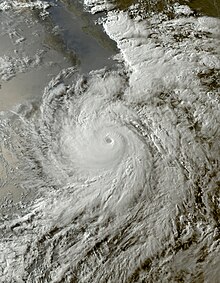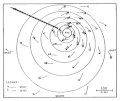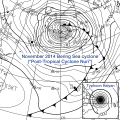Portal:Tropical cyclones
The Tropical Cyclones Portal
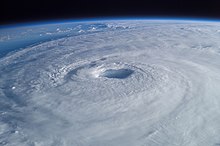
A tropical cyclone is a storm system characterized by a large low-pressure center, a closed low-level circulation and a spiral arrangement of numerous thunderstorms that produce strong winds and heavy rainfall. Tropical cyclones feed on the heat released when moist air rises, resulting in condensation of water vapor contained in the moist air. They are fueled by a different heat mechanism than other cyclonic windstorms such as Nor'easters, European windstorms and polar lows, leading to their classification as "warm core" storm systems. Most tropical cyclones originate in the doldrums, approximately ten degrees from the Equator.
The term "tropical" refers to both the geographic origin of these systems, which form almost exclusively in tropical regions of the globe, as well as to their formation in maritime tropical air masses. The term "cyclone" refers to such storms' cyclonic nature, with anticlockwise rotation in the Northern Hemisphere and clockwise rotation in the Southern Hemisphere. Depending on its location and intensity, a tropical cyclone may be referred to by names such as "hurricane", "typhoon", "tropical storm", "cyclonic storm", "tropical depression" or simply "cyclone".
Types of cyclone: 1. A "Typhoon" is a tropical cyclone located in the North-west Pacific Ocean which has the most cyclonic activity and storms occur year-round. 2. A "Hurricane" is also a tropical cyclone located at the North Atlantic Ocean or North-east Pacific Ocean which have an average storm activity and storms typically form between May 15 and November 30. 3. A "Cyclone" is a tropical cyclone that occurs in the South Pacific and Indian Oceans.
Selected named cyclone -
Hurricane Bud was a tropical cyclone that brought winds and severe flooding to Mexico throughout its existence as a tropical cyclone in June 2018. It was the second named storm, hurricane, and major hurricane of the 2018 Pacific hurricane season.[1] Bud originated from a tropical wave that departed from Western Africa on May 29. It traveled across the Atlantic Ocean before entering the Northeast Pacific Ocean late on June 6. The system moved towards the northwest and steadily organized, becoming a tropical depression on June 9 and Tropical Storm Bud early the next day. Favorable upper-level winds, ample moisture aloft, and warm sea surface temperatures allowed the storm to rapidly intensify to a hurricane late on June 10, and further to a major hurricane on the following day. Bud ultimately peaked the next morning with maximum sustained winds of 140 mph (230 km/h) and a minimum central pressure of 943 mbar (943 hPa; 27.8 inHg). Its track curved more northward while the storm rapidly succumbed to the effects of upwelling. Bud made landfall on Baja California Sur as a minimal tropical storm early on June 15. On the next day, land interaction and increasing wind shear caused Bud to degenerate into a post-tropical cyclone. It opened up into a trough of low-pressure on June 16. The remnants of Bud moved towards the Southwestern United States, bringing tropical moisture and gusty winds to the region.
Bud prompted the issuance of multiple watches and warnings for Baja California Sur and western and central Mexico. Bud caused two deaths in Mexico; one in Mexico City and another in Baja California Sur. The storm also caused a damage of US$478,000. Despite remaining offshore for most of its track, the hurricane caused torrential rainfall and severe flooding in several regions. A peak rainfall total of 6.50 in (165 mm) was recorded in San Lorenzo, Sinaloa. In Guadalajara, Jalisco, hundreds of vehicles were inundated and swept away. A canal overflowed in Guadalajara, causing damage to multiple stores in a mall. At least 100 additional structures were damaged in the city. In Guerrero, hundreds of businesses and homes were flooded. Over 100 businesses in Pie de la Cuesta were damaged by strong waves. More than 60 homes in Maruata, Michoacan, experienced flood or wind damage. Severe flooding along a street in Mexico City inundated dozens of vehicles, necessitating the rescue of their passengers. Rains from Bud's remnants brought relief to drought-stricken areas and slowed the growth of wildfires in Wyoming and Colorado. The influx of moisture prompted the issuance of flash flood watches for Colorado and New Mexico, and caused flooding near Cave Creek, Arizona. (Full article...)
Selected article -
The 1903 New Jersey hurricane, also known as the Vagabond Hurricane by The Press of Atlantic City, is the first and only known North Atlantic hurricane to make landfall in the state of New Jersey since records were kept starting in 1851. The fourth hurricane of the season, the cyclone was first observed on September 12 about 550 miles (890 kilometres) northeast of Antigua. It moved quickly westward, then later turned to the north-northwest, steadily strengthening to reach a peak intensity of 100 miles per hour (155 kilometres per hour), a Category 2 on the modern-day Saffir–Simpson scale. The hurricane weakened slightly before striking near Atlantic City, New Jersey, on September 16 with winds of 80 mph (130 km/h). It weakened over Pennsylvania and became an extratropical cyclone over western New York on September 17.
Rough surf and moderate winds from the hurricane capsized several ships along the East Coast of the United States; 30 people were left missing and presumed killed from a shipwreck in Chincoteague, Virginia. Along the coast, 57 people died due to the storm. In New Jersey, the hurricane caused heavy damage, particularly near the coast and in Atlantic City. Dozens of buildings were damaged or destroyed, and damage across the state totaled $8 million (1903 USD). In New York City, high winds disrupted traffic, closed businesses, and overturned wagons, with many windows and roofs damaged. On Long Island, President Theodore Roosevelt directly experienced the effects of the hurricane while on a yacht. The life of the president was briefly threatened by the rough conditions, though none on board the yacht suffered any problems from the hurricane. (Full article...)
Selected image -
Selected season -

The 2001–02 South-West Indian Ocean cyclone season had the earliest named storm since 1992. Many storms formed in the north-east portion of the basin, and several more originated around Australia. The basin is defined as the waters of the Indian Ocean west of longitude 90°E to the coast of Africa and south of the equator. Eleven tropical storms formed, compared to an average of nine. Tropical systems were present during 73 days, which was significantly higher than the average of 58 for this basin.
Tropical cyclones in this basin are monitored by the Regional Specialized Meteorological Center (RSMC) in Réunion. The season started on November 1, 2001, and ended on April 30, 2002; for Mauritius and the Seychelles, the season continued until May 15. These dates conventionally delimit the period of each year when most tropical cyclones form in the basin; however, storms formed both before and after the designated season. The first storm was Andre, which emerged from the Australian basin as Tropical Cyclone Alex in late October. The strongest storm, Cyclone Hary, was the first very intense tropical cyclone since 2000; it hit Madagascar, where it caused lighter damage than expected but three deaths. In January, Cyclone Dina left heavy damage in the Mascarene Islands, particularly on Réunion, where it dropped 2,102 mm (82.8 in) of rainfall. The second-to-last storm was Cyclone Kesiny, which killed 33 people when it struck Madagascar in the midst of a political crisis.
(Full article...)Related portals
Currently active tropical cyclones

Italicized basins are unofficial.
- North Atlantic (2025)
- No active systems
- East and Central Pacific (2025)
- No active systems
- West Pacific (2025)
- No active systems
- North Indian Ocean (2025)
- No active systems
- Mediterranean (2024–25)
- No active systems
- South-West Indian Ocean (2024–25)
- No active systems
- Australian region (2024–25)
- No active systems
- South Pacific (2024–25)
- No active systems
- South Atlantic (2024–25)
- No active systems
Last updated: 10:38, 16 March 2025 (UTC)
Tropical cyclone anniversaries
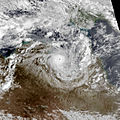
March 22
- 1984 - Cyclone Kathy (pictured) made landfall near Borroloola, Northern Territory, causing $12 million worth of damage.
- 1999 - Cyclone Vance moved ashore Western Australia, producing a wind gust of 267 km/h (166 mph) at Learmonth, one of the highest ever recorded in the country.

March 23
- 2014 - Cyclone Gillian (pictured) strengthened into a Category 5 cyclone intensity with 205 km/h (125 mph) 10-minute winds. It disrupted the search for the lost Malaysia Airlines Flight 370.

March 24
- 1985 - Cyclone Sandy struck Northern Territory, causing widespread flooding.
- 1994 - Cyclone Nadia (pictured) moved ashore Mozambique and later drifted through the country; Nadia killed 252 people along its path.
Did you know…
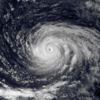



- …that the Joint Typhoon Warning Center considers that Typhoon Vera (pictured) of 1986 is actually two distinct systems, formed from two separated low-level circulations?
- …that Cyclone Freddy (track pictured) in 2023 was the longest-lasting tropical cyclone recorded?
- …that the typhoons of 2024—Yinxing, Toraji, Usagi, and Man-yi (pictured)—made history as the first recorded instance since 1951 of four tropical cyclones coexisting in November?
- …that Hurricane Otis (pictured) in 2023 was the first Pacific hurricane to make landfall at Category 5 intensity and surpassed Hurricane Patricia as the strongest landfalling Pacific hurricane on record?
General images -

North Carolina is a U.S. state located on the Atlantic Seaboard in the Southeastern United States. Tropical cyclones—storms characterized by a large low-pressure center and numerous thunderstorms that produce strong winds and heavy rain—regularly affect the state. According to statistical hurricane research between 1886 and 1996 by the North Carolina State Climatology Office, a tropical cyclone makes landfall along the coastline about once every four years. An estimated 17.5% of all North Atlantic tropical cyclones have affected the state.
This list documents 79 tropical cyclones known to have affected the state between 2000 and the present. The most active month is September, with 31 total storms, while November is the least active month with three storms. The strongest hurricane to hit the state during the time period was Hurricane Isabel in 2003, producing maximum sustained winds equivalent to Category 2 status on the Saffir–Simpson hurricane scale. In terms of impacts, Hurricane Helene in 2024 was the most destructive and the deadliest. The first storm to impact the state during the period was Florence in September 2000, and the most recent was Helene in September 2024. (Full article...)
Topics
Subcategories
Related WikiProjects
WikiProject Tropical cyclones is the central point of coordination for Wikipedia's coverage of tropical cyclones. Feel free to help!
WikiProject Weather is the main center point of coordination for Wikipedia's coverage of meteorology in general, and the parent project of WikiProject Tropical cyclones. Three other branches of WikiProject Weather in particular share significant overlaps with WikiProject Tropical cyclones:
- The Non-tropical storms task force coordinates most of Wikipedia's coverage on extratropical cyclones, which tropical cyclones often transition into near the end of their lifespan.
- The Floods task force takes on the scope of flooding events all over the world, with rainfall from tropical cyclones a significant factor in many of them.
- WikiProject Severe weather documents the effects of extreme weather such as tornadoes, which landfalling tropical cyclones can produce.
Things you can do
 |
Here are some tasks awaiting attention:
|
Wikimedia
The following Wikimedia Foundation sister projects provide more on this subject:
-
Commons
Free media repository -
Wikibooks
Free textbooks and manuals -
Wikidata
Free knowledge base -
Wikinews
Free-content news -
Wikiquote
Collection of quotations -
Wikisource
Free-content library -
Wikiversity
Free learning tools -
Wikivoyage
Free travel guide -
Wiktionary
Dictionary and thesaurus
- ^ National Hurricane Center; Hurricane Research Division; Central Pacific Hurricane Center (April 26, 2024). "The Northeast and North Central Pacific hurricane database 1949–2023". United States National Oceanic and Atmospheric Administration's National Weather Service. Archived from the original on May 29, 2024. A guide on how to read the database is available here.
 This article incorporates text from this source, which is in the public domain.
This article incorporates text from this source, which is in the public domain.

